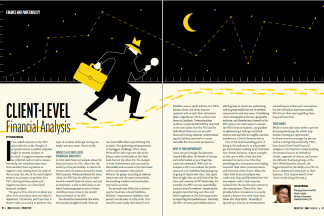AI WITHOUT THE BUZZWORDS: PRACTICAL APPLICATIONS FOR PEO LEADERS
August 2025
Everyone in your organization is using AI somewhere, somehow. If they aren’t, you should worry. If they are without much intention or discretion, be afraid.
I’m often asked about my opinion of AI and its fast adoption, given my background in both machine learning and psychological science. To be honest, it’s not a frightening revolution as much as careful evolution of iterative statistical models. What’s new is its accessibility to companies of all sizes. The real risk is that AI adoption is happening organically, without strategic thought given to where it best adds value.
Your team is already using LLMs such as ChatGPT to draft emails, Claude to analyze spreadsheets, and Copilot to quickly debug their production code. The question isn’t whether AI will transform your PEO—it’s whether you’ll guide it strategically or let it happen haphazardly, with biased decisions and unrealized value following.
Understanding these statistical models matters because they excel at pattern recognition in complex scenarios—exactly what PEO operations demand. At StoicLane, through our work with Armhr and other portfolio companies, we’ve discovered that the most successful AI implementations don’t eliminate human judgment when thoughtfully applied. Instead, they amplify it.
In this article, I explore three core operational challenges that AI can address across PEOs. Done correctly, the payoff isn’t just efficiency. It enables your team to do what we humans do best: build trust, navigate complexity, and solve contextual problems.
THE THREE PILLARS OF PEO OPERATIONAL EXCELLENCE
Every PEO executive knows the obstacles that keep them awake at night. Despite investing millions in sophisticated platforms and carefully hiring talented teams using behavioral principles, three fundamental challenges persist across the industry.
System Mastery: PEO platforms are sprawling ecosystems of interconnected modules, each with its own logic, workflows, and exceptions. New hires often take months to become proficient due to this complexity, and even experienced staff struggle with edge cases or infrequently used features.
Process Consistency: Most PEOs operate with a patchwork of outdated SOPs, tribal knowledge, and ad-hoc procedures. When documentation exists, it’s often buried in shared drives, lacks version control, and reflects how things were done rather than how they should be done. You’re left wondering which opinion to trust.
Compliance Velocity: In the PEO world, every decision carries compliance implications. The pressure to be both fast and accurate creates an impossible tension and difficult optimization curve. Move too quickly and risk regulatory violations; move too slowly and lose clients to more responsive competitors.
These challenges aren’t just operational inefficiencies. They’re barriers to the high-touch, consultative service that differentiates premium PEOs from commoditized offerings.
STRATEGIC AI APPLICATIONS: ENHANCEMENT OVER REPLACEMENT
The key to successful AI implementation lies in understanding the intersection of where human expertise is irreplaceable and where technology can eliminate friction. Here’s how forward-thinking PEOs are applying AI to each opportunity.
System Training: Intelligent Learning Companions
Traditional training approaches—remote classroom sessions, curated video libraries, or crafted wiki documentation—often fail because they’re static and disconnected from real work. AI-powered learning systems change this dynamic entirely because language models are excellent tutors to get people up to speed quickly in a bidirectional manner.
Contextual Guidance: AI assistants integrated directly into PEO platforms can provide real-time guidance based on the specific screen, client, and task at hand. Instead of searching through training materials, team members receive relevant information precisely when they need it, curated based on the rich contextual history of that employee or conversation.
Adaptive Learning Paths: Machine learning algorithms can identify knowledge gaps by analyzing user behavior patterns and tracking mistake frequencies. This enables personalized training that focuses on specific areas where individual team members need the most support.
Scenario-Based Practice: AI can generate realistic client scenarios for training purposes, allowing team members to practice navigating complex situations in a safe environment. These scenarios can be tailored to specific roles, experience levels, and common challenges that your organization experiences based on your client profile.
The result isn’t just faster team member onboarding—it’s more confident, capable team members who can handle complex situations independently while knowing when to escalate appropriately.
Process Excellence: Living Documentation Systems
Static SOPs are often dead on arrival in the dynamic PEO environment. AI-powered process management transforms documentation from a compliance checkbox into a living, breathing operational asset.
Dynamic Process Maps: AI can analyze actual workflow data to identify discrepancies between documented processes and real-world execution. This analysis reveals where existing procedures have evolved organically and highlights opportunities for refinement.
Intelligent Process Assistance: Each client situation is different, and interpreting existing documentation can require years of experience. Rather than requiring staff to search for and interpret written procedures, AI can guide them through complex processes step-by-step, adapting instructions based on client-specific requirements and regulatory considerations. This allows more accurate navigation of client situations while quickly increasing your team’s domain knowledge.
Continuous Improvement: Machine learning algorithms can identify patterns in process deviations, bottlenecks, and exceptions to suggest improvements. Like iterative software development, this creates a feedback loop where processes evolve based on real operational data rather than periodic reviews.
Version Control and Distribution: AI systems can ensure that team members always access the most current procedures while maintaining audit trails of changes and their rationale.
This approach transforms process management from a bureaucratic burden into a competitive advantage that drives consistency and efficiency.
Compliance Acceleration: Intelligent Risk Assessment
Compliance in the PEO space requires balancing speed with accuracy—a challenge that AI is uniquely positioned to address through risk-based decision support.
Risk Stratification: AI can analyze client requests, regulatory requirements, and historical data to categorize decisions by risk level. Low-risk, routine matters can be processed automatically or with minimal human oversight, while high-risk situations receive appropriate attention.
Regulatory Intelligence: Machine learning systems can monitor regulatory changes across multiple jurisdictions and automatically update relevant procedures, alerts, and decision trees. This ensures compliance guidance remains current without requiring manual monitoring of hundreds of regulatory sources.
Decision Support Systems: Rather than replacing human judgment, AI provides compliance professionals with relevant precedents, applicable regulations, and risk assessments to inform their decisions. This accelerates decision-making while maintaining human oversight for complex situations.
Audit Trail Generation: AI systems can automatically document the rationale behind compliance decisions, creating comprehensive audit trails that satisfy regulatory requirements while reducing administrative burden.
The goal isn’t to automate compliance decisions—it’s to give compliance professionals the information and confidence they need to make faster, more informed decisions.
IMPLEMENTATION FRAMEWORK: FROM VISION TO REALITY
Successfully implementing AI enhancements requires a structured approach that prioritizes quick wins while building toward transformational change.
Phase 1: Foundation Building (Months 1-3)
Start with data infrastructure and change management. AI systems require clean, accessible data and staff who understand the technology’s role in enhancing rather than threatening their positions.
Data Audit: Assess current data quality, accessibility, and governance practices. Identify gaps that could limit AI effectiveness.
Change Management: Engage team members as partners in the AI journey. Involve them in identifying obstacles and testing solutions to build buy-in and gather valuable feedback.
Pilot Selection: Choose specific use cases with clear success metrics and manageable scope. System training assistance or simple process guidance often provide excellent starting points.
Phase 2: Targeted Deployments (Months 4-9)
Focus on specific solutions that address your organization’s most pressing challenges while building internal AI capabilities.
System Integration: Deploy AI tools that integrate seamlessly with existing workflows rather than requiring separate systems or additional steps.
User Training: Provide comprehensive training on AI tool usage, emphasizing how these systems enhance rather than replace human expertise.
Feedback Loops: Establish mechanisms for collecting user feedback and measuring impact. Use this data to refine implementations and identify expansion opportunities.
Phase 3: Scaling and Optimization (Months 10-18)
Expand successful implementations and begin developing more sophisticated AI applications based on lessons learned.
Cross-Functional Integration: Connect AI systems across departments to create seamless workflows and eliminate handoff friction.
Advanced Analytics: Leverage accumulated data to develop predictive capabilities and more sophisticated decision support systems.
Continuous Improvement: Establish processes for ongoing optimization based on performance data and changing business requirements.
Phase 4: Strategic Differentiation (Months 18+)
Use AI capabilities to create sustainable competitive advantages and new service offerings.
Client-Facing Applications: Develop AI-enhanced client portals and self-service capabilities that improve client experience while reducing service costs.
Predictive Services: Offer proactive recommendations and insights based on data analysis and predictive modeling.
Market Expansion: Use AI efficiencies to serve market segments or geographic areas that were previously uneconomical.
PROPERLY MEASURING SUCCESS: BEYOND SIMPLE METRICS
Traditional ROI calculations often miss the full value of AI implementations in service-oriented businesses. Successful PEOs should track multiple dimensions to properly assess long-term impact.
If an effect isn’t measurable, you should be skeptical that it exists. This principle should guide your evaluation approach across four key areas:
Operational Efficiency: Response times, error rates, process completion times, and resource utilization provide baseline efficiency measurements.
Service Quality: Client satisfaction scores, employee confidence levels, and compliance audit results reveal whether AI enhancements improve rather than compromise service quality.
Retention and Continuity: Employee retention, client retention, and service expansion capabilities indicate whether AI investments support long-term business objectives.
Innovation Metrics: Time to implement new services, ability to serve new market segments, and competitive differentiation demonstrate AI’s role in strategic positioning.
THE HUMAN-AI PARTNERSHIP
The most successful implementations in the PEO space don’t replace human expertise—they amplify it. By handling routine tasks with more efficiency, providing intelligent assistance to increase accuracy, and accelerating decision-making to increase speed, AI frees your team to focus on relationship building, navigating complexity, and contextual problem-solving.
This human-AI partnership creates a virtuous cycle: AI handles the mechanical aspects of PEO operations, allowing humans to spend more time on high-value activities that drive client satisfaction and business growth. As AI systems learn from human expertise, they become more effective at supporting decision-making and process execution.
The PEOs that thrive won’t be those that replace their people with technology—they’ll be those that use technology to make their people more effective, more confident, and more valuable to their clients.
LOOKING FORWARD: THE COMPETITIVE IMPERATIVE
AI adoption in the PEO industry isn’t just about operational efficiency—it’s about adaptive competitiveness. At its core, AI is the scaled application of decision support systems augmented with superhuman long-term memory. When deployed thoughtfully, it enhances the precision, consistency, and responsiveness of service delivery without eroding the human relationships that form the backbone of effective PEO partnerships.
Organizations that successfully implement AI enhancements will deliver faster, more accurate, and more consistent service while maintaining the human relationships that define exceptional PEOs.
The question isn’t whether AI will shape the future of the industry—I’m certain that it will. The real question is whether your organization will model that trajectory intentionally or be reshaped by those who do. Organizations that frame AI not as automation, but as augmentation, will emerge ahead by amplifying their expertise, judgment, and interpersonal nuance in ways that already set them apart.
The future of PEO lies in understanding that AI is not an artificial surrogate for human intelligence, but a technological scaffold that elevates it, making human expertise more scalable, insights quickly actionable, and human capital more valuable.
-
SHARE
- Copy to clipboard




